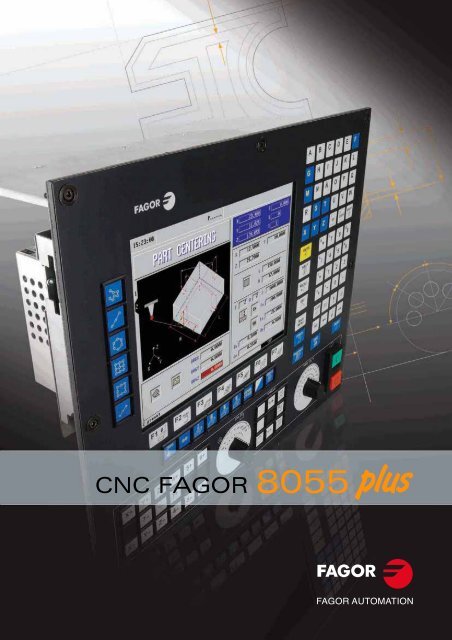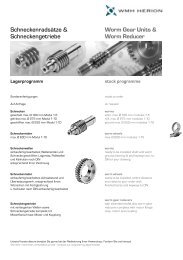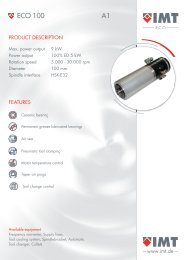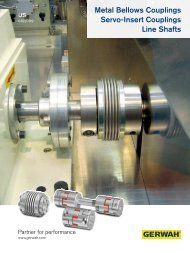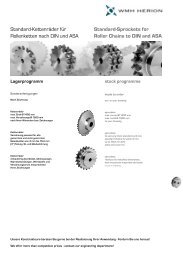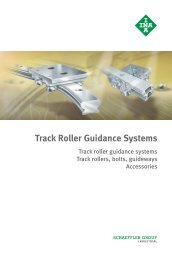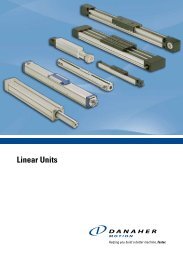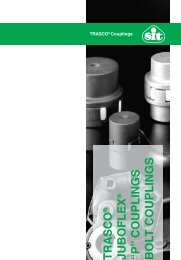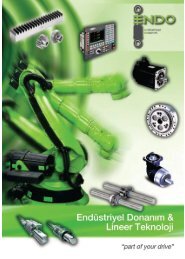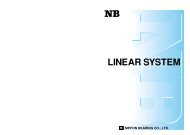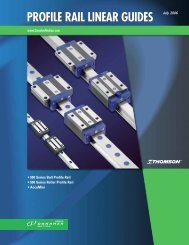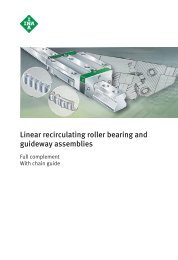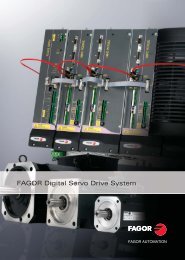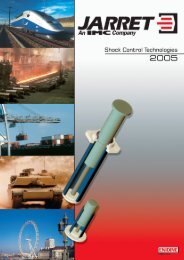CNC FAGOR 8055
CNC FAGOR 8055
CNC FAGOR 8055
- No tags were found...
You also want an ePaper? Increase the reach of your titles
YUMPU automatically turns print PDFs into web optimized ePapers that Google loves.
<strong>CNC</strong> <strong>FAGOR</strong> <strong>8055</strong>
Ideal for largeproduction linesand for unitary partsapplications<strong>FAGOR</strong> AUTOMATION has been developing automation and controlsystems for machine tools and manufacturing <strong>CNC</strong>'s, servo drives,motors and feedback systems for over 25 years.The continuous evolution of the <strong>8055</strong> <strong>CNC</strong> family contributes tothe productivity increase, improving the efficiency of the machinesin sectors requiring a robust, versatile and easy-to-install <strong>CNC</strong> system.This <strong>CNC</strong> is widely present in applications of large production linesas well as in applications for unitary parts in a shop because theoperator can use at any time either the ISO programming systemor the Fagor conversational programming system.<strong>CNC</strong> <strong>8055</strong>Central unit• Frames with a power supply for 3 or 6 modules.• The CPU and axes modules are part of all configurations.• The I/O modules, SERCOS and the CPU-turbo cards areoptional.CPU module• Up to 1Mb of user RAM memory.• Compact flash of up to 2 Gb (optional) with flash memory tostore user programs, OEM programs, PLC programs,customizing programs, parameter tables, etc.• Ethernet (optional). TCP-IP protocol.• Sercos interface (optional). For digital communication throughfiber optics between the <strong>FAGOR</strong> <strong>8055</strong> <strong>CNC</strong> and <strong>FAGOR</strong>digital servo drives (AXD/SPD).• CAN interface (optional) for digital communication betweenthe <strong>FAGOR</strong> <strong>8055</strong> <strong>CNC</strong> and <strong>FAGOR</strong> digital servo drives.Compact flashEthernetInterface SERCOS (optional)Interface CAN (optional)CPU moduleAxis moduleI/O modulePower supplysingle phase universal:85 ÷ 264 VAC, 50 HZ / 60 HZ2Axis modules• Complete module for analog solutionWith 4 analog inputs and 8 analog outputs, 1 probe input, 8feedback inputs and 40 PLC digital inputs / 24 PLC digitaloutputs (24 V DC 150 mA, opto-coupled).• Half module for digital solutionWith 4 analog inputs and 8 analog outputs, 1 probe input, 8feedback inputs and 40 PLC digital inputs / 24 PLC digitaloutputs (24 V DC 150 mA, opto-coupled).Optional cards• CPU TURBO cardAdditional 32-bit processor with math co-processor. It closesthe position loop and interpolation of the axes increasing thesystem's power by improving block processing time.CommunicationsTwo opto-coupled serial lines:RS-232 C and RS-422 (up to 115,200 Baud)Optional modules• I/O moduleIt is used to expand the basic configuration increasing thenumber of PLC digital inputs and outputs.Up to five I/O modules are possible and each offers 64 inputsand 32 outputs (24 Vdc, 150 mA) all digital and opto-coupled.• SERCOS moduleFor digital communication through fiber optics between the <strong>FAGOR</strong><strong>8055</strong> <strong>CNC</strong> and <strong>FAGOR</strong> digital servo drives (AXD / SPD).It must be used when having the CPU-turbo card.
<strong>FAGOR</strong> <strong>CNC</strong>'s are user friendly and permit editing a program whileexecuting another one. They have a profile editor with graphic supportto draw contours by entering known measurements off the blueprint.Controlling position, velocity, accelerations and collisions preventsundesired machining and help achieve unmatched part-finish andmaximum performance of the machine.The tool inspection feature makes the operator's job easier byallowing him to interrupt the program, check the tool condition,replace it if necessary, reposition the axes and then resume theexecution of the program.The <strong>8055</strong> <strong>CNC</strong> can govern up to 7 axes and 2 spindles.Block processing time of 1.5 ms may be obtained with it,it analyzes the tool path 75 blocks in advance (look ahead)and it allows smoothening the tool path by applying theright acceleration control (Jerk control).There are integrated models, <strong>8055</strong>i <strong>CNC</strong>, whose CPU isintegrated with the monitor and modular models, <strong>8055</strong><strong>CNC</strong>, whose CPU is installed in the electrical cabinet. Allmodels may be for lathes or for milling machines and cancommunicate in an analog and/or digital way with <strong>FAGOR</strong>servo systems.<strong>CNC</strong> <strong>8055</strong>-iBasic configuration• Up to 1Mb of user RAM memory.• Compact flash of up to 2 Gb (optional) with flash memory tostore user programs, OEM programs, PLC programs,customizing programs, parameter tables, etc.• USB connector for backup of programs, parameters and tables.• Ethernet (optional). TCP-IP protocol.• Opto-coupled RS-232 serial line (115,200 baud).• Feedback inputs for 2 electronic handwheels.• Interface for 2 probes.• PLC's opto-coupled digital I/O: 16 inputs and 8 outputs (24V DC, 150 mA).• Optional expansion of opto-coupled digital PLC I/O: 40 inputsand 24 outputs (24 V DC, 150 mA).• Feedback input and analog output for the spindle.• Optional analog expansion of 4 feedback inputs of 1 Vpp/TTLand 4 analog outputs.Compact flashDigital solution• SERCOS interface (optional). For digital communicationthrough fiber optics between the <strong>FAGOR</strong> <strong>8055</strong>i <strong>CNC</strong> and<strong>FAGOR</strong> digital servo drives (AXD/SPD).• CAN interface (optional) for digital communication betweenthe <strong>FAGOR</strong> <strong>8055</strong>i <strong>CNC</strong> and <strong>FAGOR</strong> digital servo drives.SERCOSor CANinterface(both optional)CAN interface(optional)Remote I/O modulesUSBEthernet (optional)Remote modules (I/O)• CAN interface (optional) to communicate with the RemoteI/O modules.• Up to 288 inputs and 192 outputs in groups of 24I/16O,48I/32O and 72I/48O. The inputs are of 24 V DC - 7 mA andthe outputs of 24 V DC - 500 mA. Terminal connection.• Remote module with 4 analog inputs, 4 analog outputs and2 inputs for temperature gages. PT100.3
<strong>CNC</strong> <strong>8055</strong> M/MCFor Milling Machinesand Machining CentersThe <strong>CNC</strong> <strong>8055</strong> M (ISO) and <strong>CNC</strong> <strong>8055</strong> MC (ISO and Conversational) models areespecially designed to work on milling machines and machining centers, both horizontaland vertical.Thanks to their features, the help improve the productivity of the processes achievingsignificant machining time reduction, improved part finish as well as considerablesetup and training time reduction.Kinematics managementIt is possible to select a typical kinematics and customize it to better adapt tothe requirements of the machine.It admits spherical, orthogonal and angular spindles; rotary tables and thecombination of swinging spindles and rotary tables.Tool calibration and measuring cyclesThey are simple and intuitive operations that make the operator's job easierusing help graphics. In the tool calibration cycle, both manual and automatic,one just needs to set the dimensions of the master part, select the tool to becalibrated and touch the part with it. The <strong>CNC</strong> picks up the actual tool dimensionsand updates its internal tables for later machining operations.By using probes placed on the tool holder spindle, the part measuring andaligning cycles help adapt easily and automatically the work coordinates to theactual part position (hole centering, corner and angle measuring, etc.).5-axis machining (RTCP)The RTCP (Rotation Tool Center Point) function improves part finish by makingthe tool tip follow the programmed profile regardless of the length and orientationof the tool.When working with RTCP and changing the orientation of the tool, the <strong>CNC</strong>moves the X, Y, Z axes to maintain the position of the tool tip on the part.Using RTCP and the Tangential control function, it is possible to machine aprofile in the plane maintaining the cutting angle of the cutter (tool position withrespect to the programmed tool path) at all times.4
Editing and simulationThe capability of editing part-programs while executing another programreduces waiting time between parts. Likewise, simulating the programgraphically before machining the part permits verifying each operationand correct the data entered.Improved production processThe Ethernet connection helps improve the production process bytransmitting part-programs, previously created in the ProgrammingOffice, to the <strong>CNC</strong> for their execution.It is also possible to monitor the machining time for statistical calculation,dead time, usage of each tool, etc.Possibility of production estimateThe simulation permits checking programs by graphically showing itsexecution. It also makes an estimate of the total execution time and ofthe machining time for each tool.Working with CAD-CAMFor those who use CAD-CAM programming, the <strong>8055</strong> <strong>CNC</strong> convertsand executes, using the WINDNC application, tool-path files and profilesgenerated in DXF format.Startup assistanceThe PLC's logic analyzer is a tool to assist you when adjusting the PLCprogram. It captures data at the beginning of each PLC cycle and showsthe status of the requested resources.The oscilloscope function is a tool to assist you when adjusting theaxes. Up to 4 variables may be shown simultaneously and manipulate<strong>CNC</strong>, PLC and drive machine parameters and variables.The circularity (roundness) test helps improve the axis reversal peak.It consists in machining a circle, graphically compare the theoreticalpath with the actual path and manipulate machine parameters until thedesired result is achieved.Intelligent profile editorBlueprints not always show the coordinates of the starting and endpoints of each section. Sometimes it suffices to just indicate the inclinationangle of a section and other times, it is enough to indicate that it istangent to the previous section.With the Intelligent Profile Editor no calculations are required, just enterthe known data into the <strong>CNC</strong>. When there are more than one solution,all possible solutions are shown graphically so the operator can selectthe right one.5
<strong>CNC</strong> <strong>8055</strong> MCConversational Model for Milling Machines and Machining CentersThanks to their versatility and capability,<strong>FAGOR</strong> conversational <strong>CNC</strong>'s for millingmachines and machining centers offerthe highest features and are incrediblyuser friendly.They minimize setup time. Any operatorwithout previous programmingknowledge will be able to efficientlyattend to any possible need by simplyentering the machining conditions andthe geometrical data shown on theblueprint.Although the <strong>CNC</strong> offers more than 10working languages, all the MC screensmay be translated to the operator's ownlanguage.Automatic operationsThe automatic operations already implemented represent the main distinguishingfeature of the conversational models. They have been designed to better adapt to theusual shop working methods. They correspond to each operation of the part machiningprocess.The keys associated with the automatic operations have a descriptive icon. All theoperations have:• Interactive graphic assistance.• Geometry defining area.• Areas to set the machining conditions for the roughing and finishing stages.All the operations have several levels, or ways, to edit with their own screen. The leftside of the screen shows tabs indicating the available levels and the one selected.Unidirectional and bidirectional surface millingProfile millingRectangular and circular pocketPockets with 2D profilePockets with 3D profileRectangular and circular boss6
Machining on ZIt permits easy definition of bolt-holedrilling, grid pattern tapping, pockets inan arc, etc.Define the type of machining in Z andassociate a multiply positioning to itindicating where the machiningoperations must be carried out.The screen is divided into 2 areas thatindicate the type of machining and itsassociated multiple positioning.Drilling Threading Point to point positioningLinear positioningArc positioning7
<strong>CNC</strong> <strong>8055</strong> TFor Lathes and Turning CentersThe <strong>FAGOR</strong> <strong>8055</strong> <strong>CNC</strong> can control high production turning centers, vertical lathes,lathes with an incline bed and parallel lathes.It offers functions for synchronizing axes and spindles in position and velocity. Theacceleration and jerk control smoothes the tool path changes and reduces mechanicalstress on the components of the machine thus making them more durable.Extremely easy to operate in jog modeThe screen offers the operator all the necessary information (axis position andfeedrate, spindle speed, selected tool, etc.).It is possible to preset the coordinates of the axes, modify the machiningconditions, select a new tool as well as start and stop the spindle, etc.The axes may be jogged with the jog keys and with handwheels.Changing the machining operationWith the <strong>8055</strong> <strong>CNC</strong>, it is very easy to change the machining on productionlathes by simply transferring to the new <strong>CNC</strong> the new part-program, the offsettables for the new fixtures and automatically calibrate the new tools beforemachining.Home searchAfter turning the machine on, there is no need to move the axes to the referencepoint (home). Using <strong>FAGOR</strong> distance-coded feedback systems, the <strong>CNC</strong>assumes the new position by simply moving the axes 50 mm; with <strong>FAGOR</strong>absolute feedback systems, there is no need to move the axes.Tool calibration and measuring cyclesThey are simple and intuitive operations that make the operator's job easierusing help graphics. The tool calibration cycle helps the operator calibrate thetool easily both manually and automatically.By using probes placed in the tool holder, the part measuring cycles helpmeasure parts or compensate for tool wear easily and automatically.Automatic tool calibration (cycles integrated into the part-program) providesbetter machining time by eliminating idle time and manual calibration.8
Intelligent profile editorBlueprints not always show the coordinates of the starting and endpoints of each section. Sometimes it suffices to just indicate the inclinationangle of a section and other times, it is enough to indicate that it istangent to the previous section.With the Intelligent Profile Editor no calculations are required, just enterthe known data into the <strong>CNC</strong>. When there are more than one solution,all possible solutions are shown graphically so the operator can selectthe right one.Thread cutting operationsAll kinds of threading are possible besides the typical turning operations(turning, grooving, facing, etc.). Standard, longitudinal, taper, on theface, with variable pitch, etc. Multiple-entry (multi-start) threads canalso be defined.The thread repair function offered by the <strong>8055</strong> <strong>CNC</strong> is ideal for restoringparts having worn out threads.Improved production processThe Ethernet connection helps improve the production process bytransmitting part-programs, previously created in the ProgrammingOffice, to the <strong>CNC</strong> for their execution.It is also possible to monitor the machining time for statistical calculation,dead time, usage of each tool, etc.Startup assistanceThe PLC's logic analyzer is a tool to assist you when adjusting the PLCprogram. It captures data at the beginning of each PLC cycle and showsthe status of the requested resources.The oscilloscope function is a tool to assist you when adjusting theaxes. Up to 4 variables may be shown simultaneously and manipulate<strong>CNC</strong> machine parameters and variables.The circularity (roundness) test helps improve the axis reversal peak.It consists in machining a circle, graphically compare the theoreticalpath with the actual path and manipulate machine parameters until thedesired result is achieved.Telediagnosis and telemaintenanceIt makes the technician's job easier since from his work table and athis own PC he can remotely manipulate and observe the status of themachine (<strong>CNC</strong>-drives-motors).It means significant savings in travel expenses and, technical assistancelabor because it reduces machine downtime by getting help and errordiagnosis immediately.9
<strong>CNC</strong> <strong>8055</strong> TCConversational Model for Lathes and Turning CentersThanks to their versatility and capability,<strong>FAGOR</strong> conversational <strong>CNC</strong>'s for lathesand turning centers offer the highestfeatures and are incredibly user friendly.They minimize setup time. Any operatorwithout previous programming knowledgewill be able to efficiently attend to anypossible need by simply entering themachining conditions and the geometricaldata shown on the blueprint.Although the <strong>CNC</strong> offers more than 10working languages, all the TC screensmay be translated to the operator's ownlanguage.Automatic operationsThe automatic operations already implemented represent the main distinguishingfeature of the conversational models. They have been designed to better adapt to theusual shop working methods. They correspond to each operation of the part machiningprocess.The keys associated with the automatic operations have a descriptive icon. All theoperations have:• Interactive graphic assistance.• Geometry defining area• Areas to set the machining conditions for the roughing and finishing stages.All the operations may be programmed for outside or inside machining and haveseveral levels, or ways, to edit with their own screen. The left side of the screen showstabs indicating the available levels and the one selected.Turning, facing, taper, rounding Threading GroovingProfilesGroovingProfiles10
"C" axis relatedautomatic operationsWhen the machine has a C axis, it ispossible to machine on the side of thepart and on its face. It is also possibleto run the machining operation onlyonce or several times, multiple drilling,multiple tapping, etc.Multiple drilling and tappingProfiles associated with the "C" axisMultiple slot millingRectangular and circular pockets associated with the C axis11
General Characteristics12CONFIGURATIONAxes and spindlesMaximum axis configuration for latheMaximum axis configuration for millingMaximum configuration of spindlesC axisMaximum axis + spindle configuration (analog + spindle)Gantry axesTandem axesAxis coupling via PLCAxis coupling via programUser memory (RAM)User memory (RAM)Compact flash (KEYCF)Integrated PLCCycle time of the PLCDirect programming in mnemonicsLogic analyzerCommunicationRS 232 (up to 115.200 Bd)RS 422DNC (through RS232)USBEthernetTelediagnosis via modemAxis adjustmentLook-ahead.Jerk controlFeed forward / AC forwardOscilloscope function (setup assistance)Circularity test (setup assistance)System architectureHardware configurationMonitorFeedback inputsFeedback inputs at the drivesAnalog inputs (±10 V)Analog inputs (±5 V)Probe inputs, 5V (0,25mA) or 24V (0.30 mA)Local digital inputs and outputs (150 mA)CPU turboCAN for connection to remote modulesCAN for digital connection with the drivesSERCOS for digital connection with the drivesRemote I/O modules (option)Possible nodes (CAN Open)Possible inputs / outputs in each node (500 mA)System voltage supplyCentral unitDigital inputs and outputsRemote I/O modulesServo drive systemsAnalogDigital SERCOS (for AXD / SPD drives)Digital CAN (for ACSD / SPD drives)ModelsMillingLatheConversationalmillinglatheConversational openmillinglatheGeneral purpose● Standard ▲ Option - Not Available<strong>8055</strong> / A <strong>8055</strong>-plus <strong>8055</strong>-i / A <strong>8055</strong>-i plus2442-5256 K1MB-75 blocksModular central unit10.4" Color VGA TFT LCD8 feedback inputs for axes, spindles andhandwheelsRequires SERCOS option8 analog outputs for axes and spindles42--MTMCTCMCOTCOGP512 MB2 GB40 l / 24 O232 l / 120 OUniversal AC24 V dc24 V dc247472(on 4 and 7-axis lathe)81MB-75 blocks42--MTMCTCMCOTCOGP2442-5Only with SERCOS digital256 K1MB3 ms / 1.000 instruc.1 ms / 1.000 instruc.-75 blocksCentral unit integrated into the monitorLCD TFT 10,4" color VGA10.4" monochrome STN LCD1 specific for spindle2 specific for electronic handwheels4 for axes, spindles or handwheelsRequires SERCOS option1 specific for spindle4 for axes, spindles-2-472 l / 48 OMTMCTCMCOTCOGP512 MB2 GB16 l / 8 O56 I / 32 O24 V dc24 V dc24 V dc247 (with digital interface)47 (with digital interface)2(on 4 and 7-axis lathe)81MB-75 blocks-2-472 l / 48 OMTMCTCMCOTCOGP
General FeaturesFor Milling Machines, Machining Centersand General Purpose MachinesFEATURESSpindle relatedSpindle orientation M19InterpolationLinear, circular, helicalTangential controlRetrace functionRTCP function (only on PLUS model with 7 axes)CompensationsTool length and radiusTool life monitoringGraphicsTool path3 simultaneous views (with depth simulation)Solid graphicsOperation relatedSimulation with execution time estimateLook-ahead of N blocks to avoid tool collisionProgramming related functionsFeedrate as an inverted function of timeProfile editorCommunications related functionsEthernetDNC (DNC communications)TelediagnosisSetup assistanceCanned cyclesMachining canned cyclesMultiple-positioning canned cyclesProbing canned cyclesDigitizing (only on PLUS model)Irregular pockets with islandsRigid TappingFor Lathes and Turning CentersFEATURESSpindle relatedSpindle orientation M19Spindle synchronizationInterpolationLinear, circular, helicalTangential controlRetrace functionC axis. (only on PLUS model with 7 axes)Y axis for lathe (only on PLUS model with 7 axes)CompensationsTool length and radiusTool geometryTool life monitoringGraphicsTool pathSolid graphicsOperation relatedSimulation with execution time estimateLook-ahead of N blocks to avoid tool collisionProgramming related functionsFeedrate as an inverted function of timeProfile editorCommunications related functionsEthernetDNC (DNC communications)TelediagnosisSetup assistanceCanned cyclesMachining canned cyclesProbing canned cyclesRigid tappingT TC TCO● Standard ▲ Option - Not Available13
CLEARINSModular ConfigurationCentral Unit 10,4” LCD Monitor (color) Operator Panel Panel ISO (*)Keyboardswitcher KS 50/55125 (4.921)325 (12.795)150 (5,90)347 (13.661)389 (15.315)240 (9.45)240 (9.45)240 (9,45)112 (4.477(3.03)38(1.50)325 (12.795)253 (9.961)274.5 (10.807)Central Unit size 3(*) Requires keyboardswitcher KS 50/55245 (9.646)287.8(11.33)347 (13.661)68.5(2.7)389 (15.315)5 (0.2)253 (9.961)274.5 (10.807)Central Unit size 6Central Unit - Monitor (color) Operator PanelPanel ISO (*)Keyboardswitcher KS 50/55325 (12.795)150 (5,90)240 (9.45)240 (9.45)240 (9,45)112 (4.477(3.03)38(1.50)325 (12.795)(*) Requires keyboardswitcher KS 50/5515
<strong>FAGOR</strong> AUTOMATION,state-of-the-art technologyFagor Automation S. Coop.Bº San Andrés, 19 – P.O.Box 144E-20500 Arrasate-Mondragón, SpainTel. 34 943 719 20034 943 039 800Fax: 34 943 791 712E-mail: info@fagorautomation.eswww.fagorautomation.comER-073/1994Modular servo drive systemIt is configured with power supply modulesthat may be connected directly to mains andwith specific drive modules to govern axisand spindle motors.· Non-regenerative power supplies (PS)· Regenerative power supplies (XPS, RPS)· Axis drives (AXD)· Spindle drives (SPD)EUROPEDE - Fagor Automation GmbH (Göppingen)Tel. 49 7161 15 6850 Fax: 49 7161 15 685 79ES - Fagor Automation Catalunya (Barcelona)Tel. 34 934 744 375 Fax: 34 934 744 327FR - Fagor Automation France S.à.r.l. (Clermont Ferrand)Tel. 33 473 277 916 Fax: 33 473 150 289GB - Fagor Automation UK Ltd. (West Midlands)Tel. 44 1327 300 067 Fax: 44 1327 300 880IT - Fagor Italia S.R.L. (Milano)Tel. 39 0295 301 290 Fax: 39 0295 301 298PO - Fagor Automation Ltda. (Leça da Palmeira)Tel. 351 229 968 865 Fax: 351 229 960 719Compact servo drive systemIndependent drive with integrated powersupply. They may be connected directly tomains.· Axis drives ((ACD, ACSD, MCS)· Spindle drives (SCD)RU - Fagor Automation Russia. (Moscow)Tel. 7 926 795 29 12AMERICABR - Fagor Automation do Brasil Com. Imp. Exp. Ltda. (São Paulo)Tel. 55 11 56 94 08 22 Fax: 55 11 56 81 62 71CA - Fagor Automation Ontario (Mississauga)Tel. 1 905 670 74 48 Fax: 1 905 670 74 49Fagor Automation Quebec (Montreal)Tel. 1 450 227 05 88 Fax: 1 450 227 61 32Spindle motorsSmall asynchronous motors balanced for highspeed. They cover a power range between3.7 Kw and 60 Kw with very low noise andvibration levels.· FM7 E01 speeds of up to 9,000 rpm.· FM7 E03 speeds of up to 15,000 rpm. Dualwinding, Y/Delta (star/triangle)· FM7 HS3 speeds of up to 15,000 rpm.Direct drive with a hole in the shaft for toolcooling.Axis motorsSynchronous motors with speeds of 3,000,4,000, 4,500 and 6,000 rpm and a stall torquefrom 1.7 Nm to 76.6 Nm.Fagor Automation Windsor (Canada)Tel. 1 519 944 56 74 Fax: 1 519 944 23 69US - Fagor Automation Corp. (Chicago)Tel. 1 847 98 11 500 Fax: 1 847 98 11 311Fagor Automation West Coast (California)Tel. 1 714 957 98 85 Fax: 1 714 957 98 91Fagor Automation East Coast (New Jersey)Tel. 1 973 773 35 25 Fax: 1 973 773 35 26Fagor Automation Ohio Branch (Ohio)Tel. 1 614 855 5720 Fax. 1 614 855 5928Fagor Automation South East (Florida)Tel. 1 813 654 45 99 Fax: 1 813 654 3387ASIACN - Beijing Fagor Automation Equipment Co., Ltd. (Beijing)Tel. 86 10 84505858 Fax: 86 10 84505860Beijing Fagor Automation Equipment Ltd. (Nanjing)Tel. 86 25 83 32 82 59 Fax: 86 25 83 32 82 60Beijing Fagor Automation Equipment Ltd. (Chengdu)Tel. 86 28 66 13 20 81 Fax. 86 28 66 13 20 82Beijing Fagor Automation Equipment Co., Ltd. (Guangzhou)Tel. 86 20 86 55 31 24 Fax: 86 20 86 55 31 25Beijing Fagor Automation Equipment Co., Ltd. (Shanghai)Tel. 86 21 63 53 90 07 Fax: 86 21 63 53 88 40Linear feedback systemsHigh performance, incremental linearencoders with measuring lengths between0.070 m and 30 m, 0.1μm resolution and 3μm accuracy. They use TDMS (Thermallydetermined mounting system) that preventsmeasuring errors due to temperature changes.General characteristics: Vibration: 20g, inpact:30g, speed: 120 m/min.<strong>FAGOR</strong> AUTOMATION shall not beheld responsible for any printing ortranscribing errors in this catalog andreserves the right to make any changesto the characteristics of its productswithout prior notice.HK - Fagor Automation (Asia) Ltd., ( Hong Kong)Tel. 852 23 89 16 63 Fax: 852 23 89 50 86IN - Fagor Control System Pvt. Ltd. (Bangalore)Tel. +91 (0)8042682828 Fax: +91 (0)8042682816KR - Fagor Automation Korea, Ltd. (Seoul)Tel. 82 2 21 13 03 41 / 2113 0342 Fax: 82 2 21 13 03 43MY - Fagor Automation (M) SDN.BHD. (Kuala Lumpur)Tel. 60 3 8062 2858 Fax: 60 3 8062 3858SG - Fagor Automation (S) Pte. Ltd. (Singapore)Tel. 65 68417345 / 68417346 Fax: 65 68417348TW - Fagor Automation Taiwan Co. Ltd. (Taichung)Tel. 886 4 2 385 1558 Fax: 886 4 2 385 1598Fagor Automation holds the ISO 9001 Quality System Certificateand the CE Certificate for all its products.helvetica - <strong>8055</strong> plus - EN 0608Worldwide reliability


